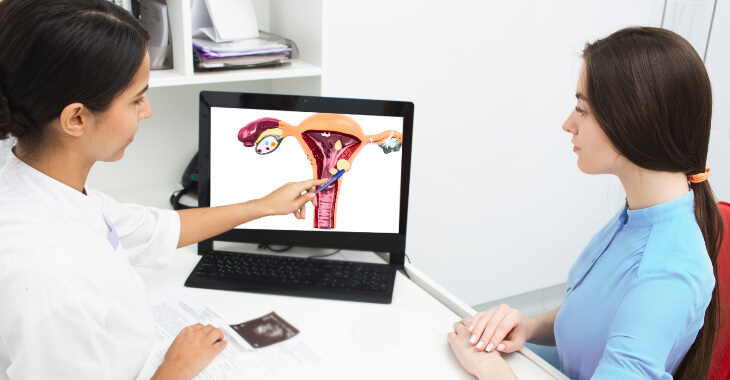Minimally Invasive (Non-Surgical) Treatment of Uterine Fibroids in NYC

Uterine fibroids affect millions of women at various stages of their life. These non-cancerous growths can occur inside or outside the uterus in adult women of all ages. Uterine fibroids are linked to reproductive hormones, but the exact cause of their formation is not always known. The symptoms of uterine fibroids can impact the quality of life for many women, including excessive menstrual bleeding and pain. Hysterectomy and other surgical procedures can be used for treatment, but there are minimally invasive treatments for uterine fibroids.
Symptoms of Uterine Fibroids
The main symptoms of uterine fibroids occur with menstruation. Menstrual bleeding can become heavier and more frequent, and periods can be longer. Many women experience increased cramping and pain with their menstrual cycle. Lower pelvic and back pain may occur, and some women experience pain during sexual intercourse. While uterine fibroids do not usually impact fertility, it is possible, and fibroids can cause complications during pregnancy and labor.
Alternative to Hysterectomy for Fibroids
For many years, the main treatment for uterine fibroids was a hysterectomy. This involves surgically removing the uterus, which has many implications. A hysterectomy prevents any future pregnancies and can change hormonal production. It is also very invasive and requires extensive recovery. For women who may want to have children in the future, a hysterectomy is a devastating option to relieve the pain and discomfort caused by their uterine fibroids. Another option is uterine fibroid embolization or UFE.
Non-Surgical Uterine Fibroid Embolization (UFE)
Advanced medical technology has improved many treatment options, including those for uterine fibroids. Uterine fibroid embolization, or UFE, is a non-surgical, minimally-invasive treatment and alternative to hysterectomy or surgical treatment. This FDA-approved uterine fibroid procedure is performed under conscious sedation in about 30 minutes. Patients can return home to recover after their procedure and very little downtime is required.
UFE works by targeting the blood vessels that connect to the fibroids in the uterus. A catheter is placed inside the femoral artery in the groin to access the uterine arteries – some surgeons may access the circulatory system through the wrist. A contrasting agent is released into the blood flow to help identify the blood vessels and fibroids. Once the fibroids and blood vessels are detected, a substance is released into the identified blood vessels that contain particles that will block the blood flow to the fibroids.
During the procedure, the patient is relaxed under conscious sedation. The incision site is numbed with a local anesthetic. There is rarely any discomfort during the procedure and minimal possible side effects after the treatment. Patients will need to have a responsible adult to ensure they get home safely, as they will still be under the effects of the sedation. There is a short recovery period, and most patients can return to normal activities quickly after their procedure.
Advantages of UFE
A hysterectomy or surgery to remove fibroids are the other alternatives for uterine fibroids treatment. UFU offers a less invasive option with fewer risks, side effects, and long-term consequences. The procedure only takes about half an hour and most patients are home again soon after. Over the following months, the fibroids shrink as blood flow is blocked. The symptoms begin to dissipate, reducing the length and heavy flow of menstrual periods and minimizing discomfort.
Compared to other treatments for uterine fibroids, UFE offers a minimally invasive solution to absolve symptoms without surgery. Patients can still become pregnant, and their hormone balance is not changed by the procedure. For many, UFE can be an effective, less invasive, and cost-effective alternative to a hysterectomy or surgical removal of fibroids.
If you have been diagnosed with uterine fibroids and want to explore solutions, consider uterine fibroid embolism. This minimally invasive treatment may be the best way to give you relief from your uterine fibroids without the risk, expense, or recovery of surgery.
Posted on behalf of Dr. Karl Zhang New York, NY | Non-Surgical Uterine Fibroid Treatment Specialist
The information provided on this website, including text, graphics, images, and other materials, is intended solely for informational purposes and should not be used as a substitute for professional medical advice, diagnosis, or treatment.



)